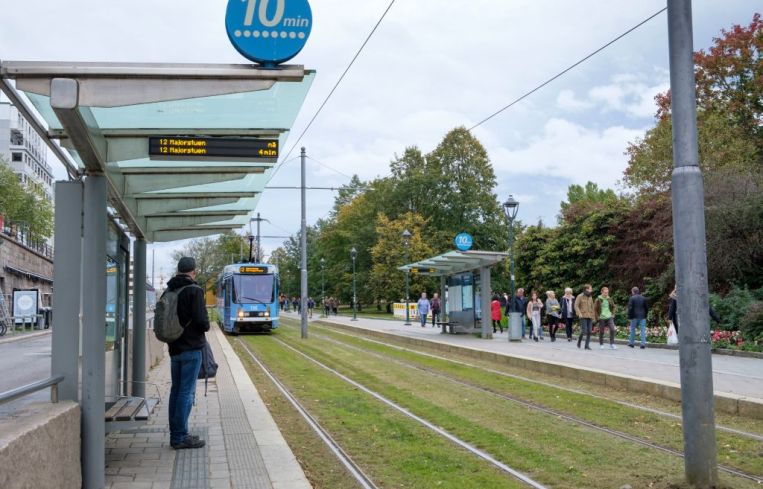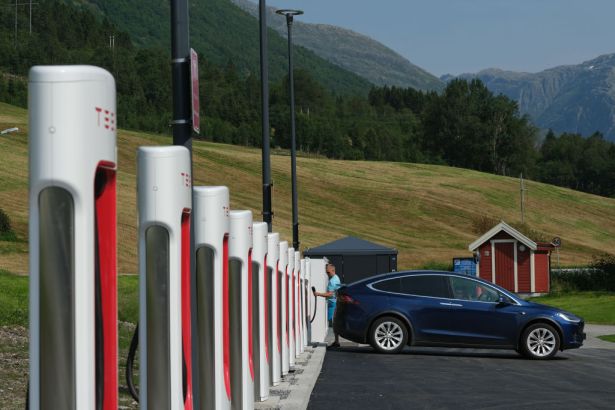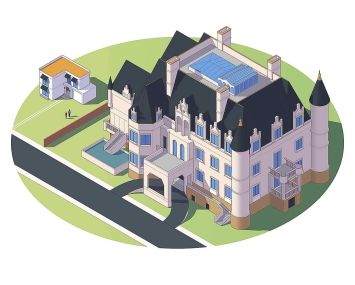Both Public and Private Transportation in Oslo Are Close to Going Fully Electric
Over 82 percent of passenger cars purchased in Norway in June were electric
By Anna Staropoli July 10, 2023 4:57 pm
reprints
Bright blue trams run between Oslo’s pastel buildings. The colorful transit cars make a loud visual splash, but they barely make a sound as they glide by. Silence is a hallmark of electric transportation, for which Norway is leading the charge globally.
The Norwegian capital has widely restricted car access along its central streets. On the select roads where cars may roam, they drift by as silently as those trams, with license plates indicating whether the vehicle is fully electric. Instead, charging stations, electric scooters and wide, well-marked bike lanes abound, so Oslo residents and tourists can choose how best to traverse the city — no gas necessary.
These electrification efforts reflect both the city and country’s climate goals, as well as a national sentiment that has largely welcomed the changes over a decades-long transition. Norway has put electrification at the forefront of its climate efforts, despite the fact that the Scandinavian country, known for its Arctic temperatures, snow-blanketed towns and astonishing lack of sunlight during its polar winter, is hardly the first place that comes to mind when thinking green.
On a national scale, the Norwegian Parliament set the goal that all new cars sold by 2025 should be electric, which generally means they’re producing zero direct emissions. Oslo has set its sights on 100 percent all-electric passenger cars by 2030, but plans to provide zero-emission public transport by this year, meaning, the Norwegian capital plans to replace its diesel-fueled buses with 450 all-electric ones. And at the year’s halfway mark, Oslo is well on track toward achieving these aims. Once fully updated, Oslo’s transit system will be the world’s first to go all-electric.
“Oslo is a special city in Norway, so here we can see that public transport has a big market,” Cecilie Knibe Kroglund, Norway’s state secretary in the Ministry of Transport, told CO about Norway’s efforts to electrify. “But, all around Norway, the car has an important place. So to be environmental, we have to choose the electric car because public transport is not always an alternative for most Norwegians.”
Norway’s strides toward electrification encompass both public infrastructure, such as government-managed buses and trams, as well as individual choice.
Norway’s passenger car market amounts to roughly 2.9 million vehicles, and currently stands at 21.6 percent electric, according to data from the Norwegian Ministry of Transport, while 15.5 percent of all segments of Norwegian vehicles — cars, trucks, buses, tractors and so on — are electric.
That percentage is increasing. Among new passenger cars bought in June 2023, zero-emission cars had an 82.2 percent market share, up from 70.7 percent from a year prior. For comparison, the estimated market share of electric cars in the U.S. is likely to be about 18 percent for 2023.
“We have come to the point where people want to choose electrical vehicles,” said Knibe Kroglund. “I think that people can see that it works. It’s cheaper and it’s better for the environment — not even just for the climate, but also for the environment.”
Norway has had widespread success in converting to electric cars thanks to a concerted effort by the government, which leveraged incentives and investment in charging infrastructure to lower the cost and increase the convenience of electric vehicles. On the incentive end, both national and local tax exemptions have contributed to the change in customers’ preferences, said Knibe Kroglund. These incentives vary, but include reductions in road taxes, ferry fees and parking payments, among other rewards. Some of these incentives were put in place as early as the 1990s.
“Afterwards, you have to lower down the incentives,” said Knibe Kroglund. “We are almost there, and now it’s a commercial market for chargers. It’s a period to get through — to get people to choose a new path — and, afterward, when they have discovered the good sides of it, we have done our job.”
The availability and accessibility of charging stations has likewise eased the process of electrification for the average car owner. Gasoline and diesel are very expensive these days, said Knibe Kroglund, so despite the energy crisis spurred by the war in Ukraine, electric transit still comes cheaper than conventional cars.

“In the beginning, when I bought my car 10 years ago, it was cheap,” said Knibe Kroglund. “And then I charged at home. It was almost free because the electric bill was low. And we have always been fortunate in Norway to have cheap electrical bills.”
Most Norwegians can charge their cars at home — and most Norwegians do, a difference that distinguishes Norway from other countries where charging stations are less readily accessible, said Knibe Kroglund. Yet even if individual households lack an at-home charging station, public charging stations remain accessible and easy to find; apps across Norway tell users where available chargers are located and keep the infrastructure for information readily in place.
“Almost 83 percent of new cars sold in 2023 are zero-emission,” said Knibe Kroglund. “It’s the mixture of people wanting to try zero-emission, and it’s also easier than it was. More than a few years ago, it was difficult to drive long distances for electric cars.”
The political dynamic that allowed the implementation of incentives and charging infrastructure deserves some credit for the large-scale success of Norway’s electrification. Many countries have incentives and the goodwill to manage the transition to electrification, said Knibe Kroglund, but unlike some other countries, Norway has a unique political resource: agreement.
“Most political parties agree on this,” said Knibe Kroglund. “And when we have the incentives, like the government agency — Enova — that has a lot of money to support the goals, maybe it has also been done in the right way.”
As for where the funding comes from, the government is to thank, as is an indirect, but surprising, source: the oil industry. The Government Pension Fund uses some of the revenue made from petroleum to help finance Norway’s electrification.“We have this Norwegian oil fund, where the amount we get from the oil industry goes into a fund, so we use a big percent of this in the state budget,” said Knibe Kroglund. “That makes the Norwegian economy a good economy.”
Back in Oslo, more intangible forms of green infrastructure — electric scooters, bike lanes — further emphasize the integration of green transit with Norwegian daily life. The scooters weren’t a political choice, clarified Knibe Kroglund. “[After they came], we had to make adjustments to make them live in harmony with other transports,” she said. “A lot of those things are driven commercially, but I think if we use Enova, we make firms and businesses innovate.”
Norway has a ways to go for green vehicles, particularly boats and ferries, but the benefits are already palpable, both environmentally and socially, said Knibe Kroglund.
“People interact differently now when big areas in the center are free from cars, of course,” said Knibe Kroglund. “Also, I think it impacts peoples’ economic choices; people choose cheaper alternatives, not only because they want to, but because they need to.”
Cleaner air is another byproduct of Norway’s electrification that immediately impacts people’s quality of life.
When people see the positives to electrification, Knibe Kroglund said, it becomes a no-brainer. “This is not the most difficult decision we have when it comes to green choices. This part of the sector — transport sector — is easier to agree on.”
Anna Staropoli can be reached at astaropoli@commercialobserver.com.


